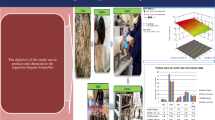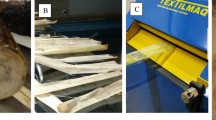Abstract
This study evaluated the effects of the temperature and pressure used when compacting banana leaves on viscoelastic properties and briquette quality. Banana leaves with 12.4% of humidity were milled at two ranges of average particle size. The briquetting was carried out in a cylinder-piston device coupled to a universal mechanical test machine, under different compacting temperatures (30 and 120 °C) and pressures (20, 40 and 60 MPa). Several parameters, including compacting module, porosity index, final density, critical density, compacting energy, compression ratio, higher heating value, and energy density, were investigated. The banana leaf particles smaller than 1.7 mm performed better during compaction, with low compacting resistance. Temperature showed less influence on final density than pressure. The increase of pressure contributed to decreasing the compacting module and to achieving denser briquettes. It was not necessary to apply high temperature to obtain briquettes with high final density and energy density. The optimum briquetting process parameters identified can be used to produce briquettes from banana leaves at an industrial scale with an extruder. Briquetting adds value to banana leaf waste and reduces environmental pollution.





Similar content being viewed by others
Data availability
The datasets used and/or analyzed during the current study are available from the corresponding author on reasonable request.
References
Alves J, da Trindade E, da Silva J, Mumbach G, Alves R, Barbosa Filho J, de Athayde-Filho P, de Sena R (2020) Lignocellulosic residues from the Brazilian juice processing industry as novel sustainable sources for bioenergy production: preliminary assessment using physicochemical characteristics. J Braz Chem Soc 31:1939–1948. https://doi.org/10.21577/0103-5053.20200094
Alves JLF, da Silva JCG, Sellin N, Prá F de B, Sapelini C, Souza O, Marangoni C (2021) Upgrading of banana leaf waste to produce solid biofuel by torrefaction: physicochemical properties, combustion behaviors, and potential emissions. Environ Sci Pollut Res. https://doi.org/10.1007/s11356-021-17381-x
ASTM - American Society for Testing and Materials (2000) ASTM D2015–00 - standard test method for gross calorific value of coal and coke by the adiabatic bomb calorimeter. ASTM International, West Conshohocken, PA.
ASTM - American Society for Testing and Materials (2004) ASTM E828–81. Standard test method for designating the size of RDF-3 from its sieve analysis. ASTM International, West Conshohocken, PA.
ASTM - American Society for Testing and Materials (2010) ASTM D5057 - 10 - Standard test method for screening apparent specific gravity and bulk density of waste. ASTM International, West Conshohocken, PA.
Bhushan S, Rana MS, Mamta NN, Prajapati SK (2019) Energy harnessing from banana plant wastes: a review. Bioresour Technol Reports 7:100212. https://doi.org/10.1016/j.biteb.2019.100212
Bolufawi SJ, Bamgboye AI (2014) Evaluation of some handling and processing parameters for briquetting of guinea corn (Sorghum bi-color) residue. African J Biotechnol 13:4320–4329. https://doi.org/10.5897/AJB11.079
Castellano JM, Gómez M, Fernández M, Esteban LS, Carrasco JE (2015) Study on the effects of raw materials composition and pelletization conditions on the quality and properties of pellets obtained from different woody and non woody biomasses. Fuel 139:629–636. https://doi.org/10.1016/j.fuel.2014.09.033
CEPA (2018) Centro de Socioeconomia e Planejamento Agrícola, CEPA - EPAGRI, Santa Catarina, Available at https://docweb.epagri.sc.gov.br/website_cepa/publicacoes/Sintese_2018_19.pdf, Accessed on May (2021) (in Portuguese).
de Oliveira PRS, Trugilho PF, de Oliveira TJP (2021) Briquettes of acai seeds: characterization of the biomass and influence of the parameters of production temperature and pressure in the physical-mechanical and energy quality. Environ Sci Pollut Res. https://doi.org/10.1007/s11356-021-16529-z
Faborode MO, O’Callaghan JR (1986) Theoretical analysis of the compression of fibrous agricultural materials. J Agric Eng Res 35:175–191. https://doi.org/10.1016/S0021-8634(86)80055-5
Gendek A, Aniszewska M, Malaťák J, Velebil J (2018) Evaluation of selected physical and mechanical properties of briquettes produced from cones of three coniferous tree species. Biomass Bioenergy 117:173–179. https://doi.org/10.1016/j.biombioe.2018.07.025
Gilbert P, Ryu C, Sharifi V, Swithenbank J (2009) Effect of process parameters on pelletisation of herbaceous crops. Fuel 88:1491–1497. https://doi.org/10.1016/j.fuel.2009.03.015
Guerrero AB, Ballesteros I, Ballesteros M (2018) The potential of agricultural banana waste for bioethanol production. Fuel 213:176–185. https://doi.org/10.1016/j.fuel.2017.10.105
Kaliyan N, Vance Morey R (2009) Factors affecting strength and durability of densified biomass products. Biomass Bioenergy 33:337–359. https://doi.org/10.1016/j.biombioe.2008.08.005
Lai ZY, Chua HB, Goh SM (2013) Influence of process parameters on the strength of oil palm kernel shell pellets. J Mater Sci 48:1448–1456. https://doi.org/10.1007/s10853-012-6897-x
Larsson SH, Rudolfsson M, Nordwaeger M, Olofsson I, Samuelsson R (2013) Effects of moisture content, torrefaction temperature, and die temperature in pilot scale pelletizing of torrefied Norway spruce. Appl Energy 102:827–832. https://doi.org/10.1016/j.apenergy.2012.08.046
Maia BG de O, de Oliveira APN, de Oliveira TMN, Marangoni C, Souza O, Sellin N (2018) Characterization and production of banana crop and rice processing waste briquettes. Environ Prog Sustain Energy 37:1266–1273. https://doi.org/10.1002/ep.12798
Mandal S, Prasanna Kumar GV, Bhattacharya TK, Tanna HR, Jena PC (2019) Briquetting of pine needles (Pinus roxburgii) and their physical, handling and combustion properties. Waste Biomass Valorization 10:2415–2424. https://doi.org/10.1007/s12649-018-0239-4
Mohd Faizal H, Latiff ZA, Mohd Iskandar MA (2015) Characteristics of binderless palm biomass briquettes with various particle sizes. J Teknol 77:1–5. https://doi.org/10.11113/jt.v77.6147
Montiano MG, Díaz-Faes E, Barriocanal C (2016) Effect of briquette composition and size on the quality of the resulting coke. Fuel Process Technol 148:155–162. https://doi.org/10.1016/j.fuproc.2016.02.039
Muazu RI, Stegemann JA (2015) Effects of operating variables on durability of fuel briquettes from rice husks and corn cobs. Fuel Process Technol 133:137–145. https://doi.org/10.1016/j.fuproc.2015.01.022
Nona KD, Lenaerts B, Kayacan E, Saeys W (2014) Bulk compression characteristics of straw and hay. Biosyst Eng 118:194–202. https://doi.org/10.1016/j.biosystemseng.2013.12.005
Obi OF (2015) Evaluation of the effect of palm oil mill sludge on the properties of sawdust briquette. Renew Sustain Energy Rev 52:1749–1758. https://doi.org/10.1016/j.rser.2015.08.001
Okot DK, Bilsborrow PE, Phan AN (2018) Effects of operating parameters on maize COB briquette quality. Biomass Bioenergy 112:61–72. https://doi.org/10.1016/j.biombioe.2018.02.015
Oladeji JT, Enweremadu CC (2012) The effects of some processing parameters on physical and densification characteristics of corncob briquettes. Int J Energy Eng 2:22–27. https://doi.org/10.5923/j.ijee.20120201.04
Olugbade TO, Ojo OT (2021) Binderless briquetting technology for lignite briquettes: a review. Energy, Ecol Environ 6:69–79. https://doi.org/10.1007/s40974-020-00165-3
Perrier X, De Langhe E, Donohue M, Lentfer C, Vrydaghs L, Bakry F, Carreel F, Hippolyte I, Horry J-P et al (2011) Multidisciplinary perspectives on banana (Musa spp.) domestication. Proc Natl Acad Sci 108:11311–11318. https://doi.org/10.1073/pnas.1102001108
Santana DAR, Scatolino MV, Lima MDR, Barros Junior U de O, Garcia DP, Andrade CR, Carneiro A de CO, Trugilho PF, Protásio T de P (2021) Pelletizing of lignocellulosic wastes as an environmentally friendly solution for the energy supply: insights on the properties of pellets from Brazilian biomasses. Environ Sci Pollut Res 28:11598–11617. https://doi.org/10.1007/s11356-020-11401-y
Setter C, Ataíde CH, Mendes RF, de Oliveira TJP (2021) Influence of particle size on the physico-mechanical and energy properties of briquettes produced with coffee husks. Environ Sci Pollut Res 28:8215–8223. https://doi.org/10.1007/s11356-020-11124-0
Stolarski MJ, Szczukowski S, Tworkowski J, Krzyżaniak M, Gulczyński P, Mleczek M (2013) Comparison of quality and production cost of briquettes made from agricultural and forest origin biomass. Renew Energy 57:20–26. https://doi.org/10.1016/j.renene.2013.01.005
Theerarattananoon K, Xu F, Wilson J, Ballard R, Mckinney L, Staggenborg S, Vadlani P, Pei ZJ, Wang D (2011) Physical properties of pellets made from sorghum stalk, corn stover, wheat straw, and big bluestem. Ind Crops Prod 33:325–332. https://doi.org/10.1016/j.indcrop.2010.11.014
Velusamy S, Subbaiyan A, Thangam RS (2021) Combustion characteristics of briquette fuels from sorghum panicle–pearl millets using cassava starch binder. Environ Sci Pollut Res 28:21471–21485. https://doi.org/10.1007/s11356-020-11790-0
Wongsiriamnuay T, Tippayawong N (2015) Effect of densification parameters on the properties of maize residue pellets. Biosyst Eng 139:111–120. https://doi.org/10.1016/j.biosystemseng.2015.08.009
Zepeda-Cepeda CO, Goche-Télles JR, Palacios-Mendoza C, Moreno-Anguiano O, Núñez-Retana VD, Heya MN, Carrillo-Parra A (2021) Effect of sawdust particle size on physical, mechanical, and energetic properties of Pinus durangensis briquettes. Appl Sci 11:3805. https://doi.org/10.3390/app11093805
Funding
The authors would like to thank the FAP/UNIVILLE (funds from the VALORIZAR Research Project) for the research support (student grants, equipment, supplies, reimbursement for attending symposia, and other expenses). JLFA gratefully acknowledges the postdoctoral fellowship from the National Council for Scientific and Technological Development (CNPq/Brazil Process 152245/2020–0).
Author information
Authors and Affiliations
Contributions
NS contributed to the conceptualization and supervision, and with material resources, funding acquisition, and project administration and was a major contributor to writing the original draft. OS and CM contributed to the conceptualization and supervision, and with material resources, funding acquisition, and project administration. JLFA contributed to reviewing and editing the manuscript. FBP contributed to the experimental investigation and data curation and was a major contributor to writing the original draft. CS contributed to the experimental investigation and data curation. All of the authors read and approved the final manuscript.
Corresponding author
Ethics declarations
Ethics approval and consent to participate
Not applicable.
Consent for publication
Not applicable.
Competing interests
The authors declare no competing interests.
Additional information
Responsible Editor: Ta Yeong Wu
Publisher's note
Springer Nature remains neutral with regard to jurisdictional claims in published maps and institutional affiliations.
Rights and permissions
About this article
Cite this article
Sellin, N., Prá, F.d., Sapelini, C. et al. Effect of compacting conditions on the viscoelastic properties of banana leaf waste and briquette quality. Environ Sci Pollut Res 29, 25970–25979 (2022). https://doi.org/10.1007/s11356-022-19266-z
Received:
Accepted:
Published:
Issue Date:
DOI: https://doi.org/10.1007/s11356-022-19266-z




